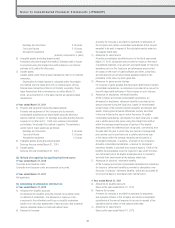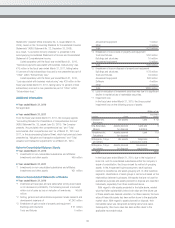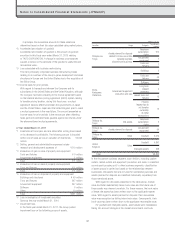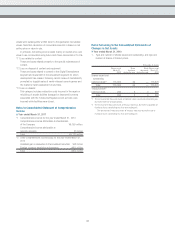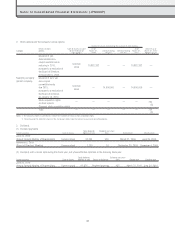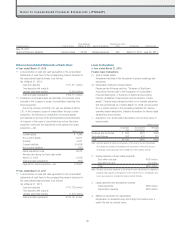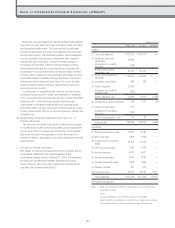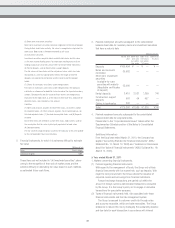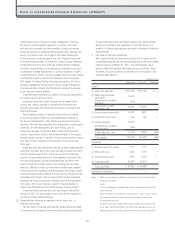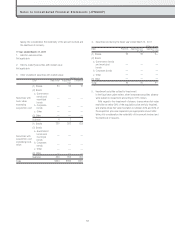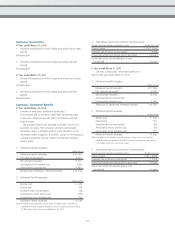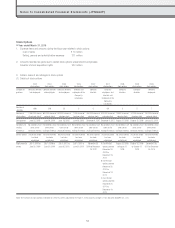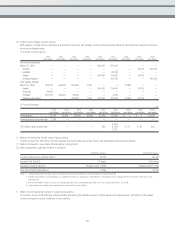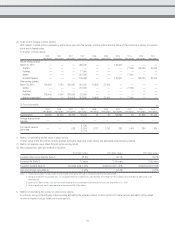Square Enix 2011 Annual Report Download - page 50
Download and view the complete annual report
Please find page 50 of the 2011 Square Enix annual report below. You can navigate through the pages in the report by either clicking on the pages listed below, or by using the keyword search tool below to find specific information within the annual report.
Notes and accounts payable are defined as those trade payables
due within one year. Short-term loans are used to meet short-term
working capital requirements. The Group avoids the settlement
liquidity risk associated with short-term payables, including notes
and accounts payable, other accounts payable, accrued expenses,
accrued corporate taxes, accrued consumption taxes, deposits
received and short-term loans, through the monthly review of
its funding plan and other methods. Although foreign currency-
denominated trade payables involve exposure to exchange-rate
fluctuations, the Group reduces this risk through similar methods
to those used to manage the risk associated with foreign currency-
denominated trade receivables. Although the Group is exposed to
interest-rate risk through short-term loans. The group, however,
is able to respond flexibly to interest rate fluctuations since the
borrowing periods are short.
Current portion of corporate bonds comprise yen zero-coupon
convertible bonds due 2010, which are redeemable in November
2010. Corporate bonds comprise euro yen zero-coupon convertible
bonds due 2015, which the Group issued in the fiscal year
under review to refinance the aforementioned corporate bonds
redeemable within one year. Since each of these bonds are issued
as zero-coupon bonds, they do not involve exposure to interest rate
fluctuation risk.
(3) Supplementary information regarding the fair value, etc., of
financial instruments
The fair value of financial instruments includes amounts based
on market prices as well as those calculated using an appropriate
formula when there is no applicable market price. Since variable
factors are included in the calculation of such fair values, the
adoption of different assumptions may lead to changes in these fair
value amounts.
2. Fair value of financial instruments
With regard to financial instruments held by the Company and its
consolidated subsidiaries, the values presented on the
consolidated balance sheet as of March 31, 2010, the estimated
fair value and the difference between these amounts are as
follows. Items for which fair value is difficult to estimate are not
included in the following table (Note 2).
Millions of yen
Book value Fair value Difference
Assets:
(1) Cash and deposits ¥111,211 ¥111,211 ¥—
(2) Notes and accounts
receivable 30,682
Allowance for doubtful
accounts (530)
Notes and accounts
receivable, net 30,152 30,152 —
(3) Short-term investment
securities ¥ 35,000 ¥ 35,000 ¥ —
(4) Investment securities 480 480 —
(5) Rental deposits 13,530
Allowance for doubtful
deposits paid (526)
Rental deposits, net 13,004 11,973 (1,030)
(6) Construction support deposits 1,125 1,087 (37)
(7) Claims in bankruptcy 202
Allowance for doubtful
accounts (180)
Claims in bankruptcy, net 21 21 —
Total assets 190,995 189,927 (1,068)
Liabilities:
(1) Notes and accounts payable 10,666 10,666 —
(2) Short-term loans 2,808 2,808 —
(3) Current portion of corporate
bonds 37,000 37,000 —
(4) Other accounts payable 3,528 3,528 —
(5) Accrued expenses 6,611 6,611 —
(6) Accrued income taxes 4,090 4,090 —
(7) Accrued consumption taxes 2,839 2,839 —
(8) Deposits received 561 561 —
(9) Corporate bonds 35,000 39,287 4,287
Total liabilities ¥103,106 ¥107,393 ¥4,287
Derivative transactions ———
Notes: 1. Matters concerning the methods for estimating fair value and short-term
investment securities
Assets
(1) Cash and deposits, and (2) Notes and accounts receivable
Since these items are settled on a short-term basis, book value is used on
the assumption that fair value is principally equivalent to book value.
Notes to Consolidated Financial Statements (JPNGAAP)
48


